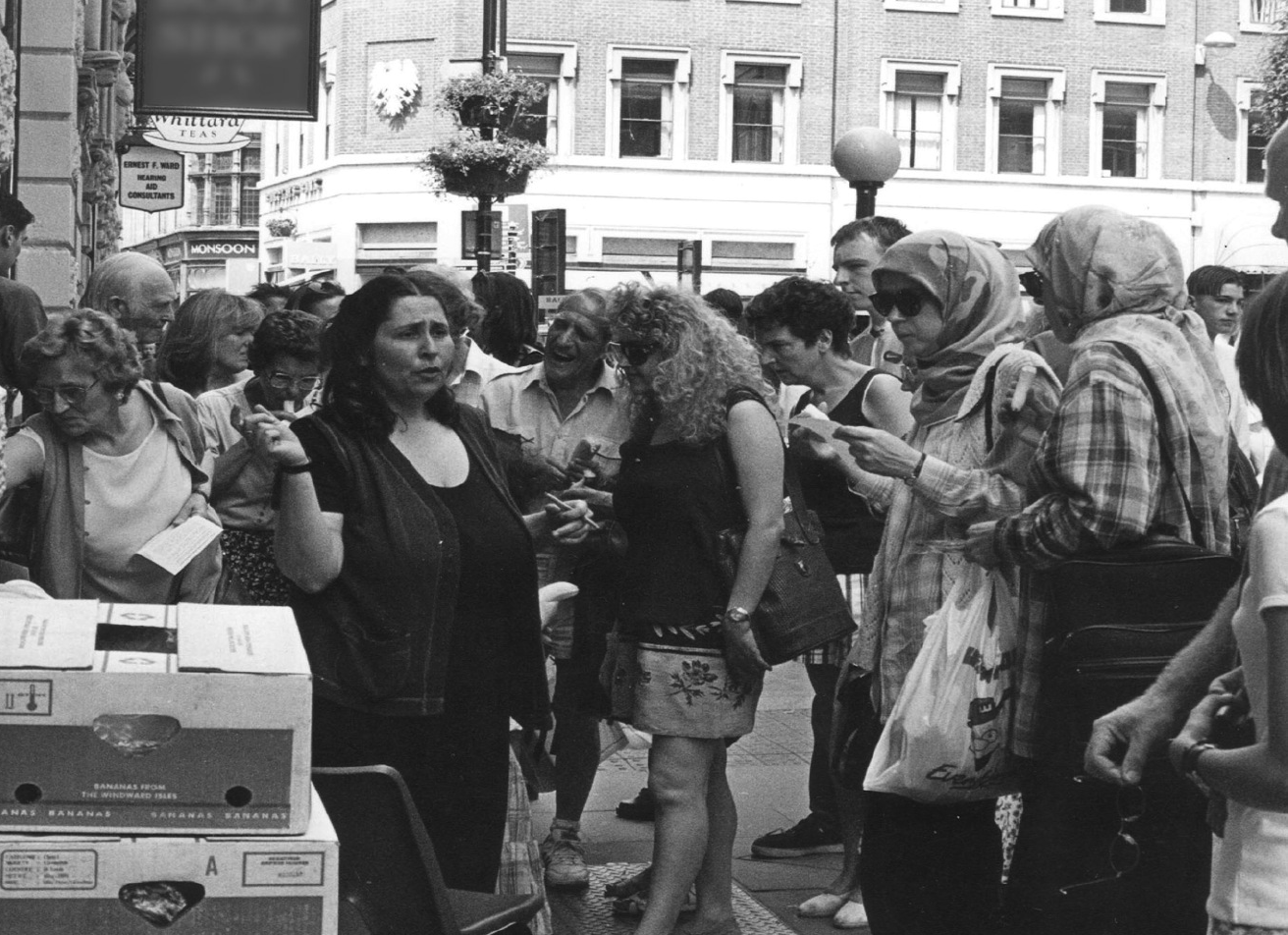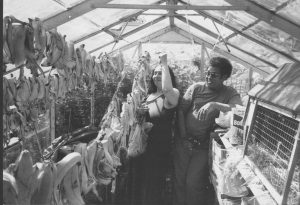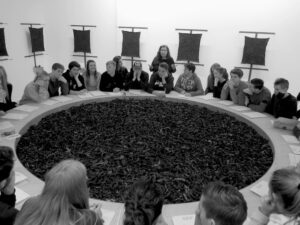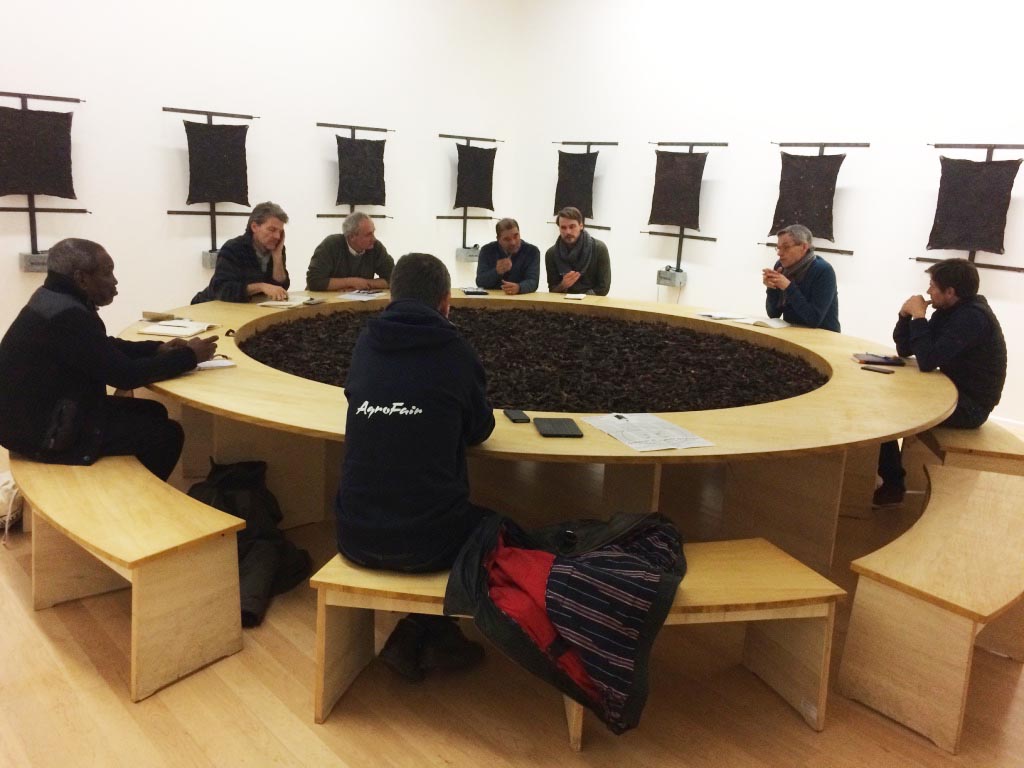In June 1996, after more than 3 years of discussions, research and planning, the process of collecting the skins from numbered boxes of bananas began.


The first plan for collecting the skins from numbered boxes was to ask supermarket consumers to return their banana skins in a freepost envelope. The grower number corresponding to their bananas would be written on the envelope when they selected the fruit. Lengthy discussions with several supermarkets at national and local level led to an agreement with one national chain that would allow the necessary contact with consumers as they selected their bananas. However, a trial dispatch of skins through the post arrived covered in mould! Clearly another method of collecting these numbered skins had to be developed, despite all the organisation that had gone into getting permission to collect the skins in supermarkets.
The only feasible alternative was to get numbered boxes of bananas from the supplier, hand the bananas out and get the skins returned on the spot.
Now I needed sponsorship for the bananas and a venue for distributing them. WIBDECO representing the Windward banana growers in London supported a request to Geest for 20 randomly selected boxes of bananas from the Windward Islands. If I was going to attempt to trace the growers, it was preferable if the boxes came from one island. Since the majority of the bananas we eat in Britain come from the Windward Islands, and more than half of these from St. Lucia, this was the obvious choice.
Getting permission to distribute the bananas in Nottingham city centre was not so easy. The Council was worried that it might cause conflict with the licensed fruit traders.
In the meantime I had also made contact with the Head of Research at the Body Shop, who was excited by the project, and had agreed to dry large quantities of ‘unnumbered’ banana skins in their kilns over the following six months, that would be used to contrast with the ‘sheets of skin’ around the walls.
On two Saturdays in June 1996, for 9 hours a day, 3000 bananas were distributed to individual passers-by. Assisted by my eight year old daughter Rosa van Wyk, as well as Rebecca Swaine, Susan Croft and my elder daughter, Khanya Price Evans – we gave every ‘eater’ of a banana the corresponding grower number in exchange for their banana skin.
Groups of people gathered throughout the day to find out more about the project and discuss questions of world trade, ‘fair trade’ and consumer responsibility provoked by the project.
After this ‘festival’ of banana eating in the city, there were 3000 skins to be hung up and dried, and to stop them moulding this was a matter of urgency! Once dry, they were stored in numbered bags ready for stitching.

Drying skins from 20 boxes, Nottingham 1996
A month later, in July 1996, we began stitching the sheets of skin. After a fairly lengthy process that included soaking, curing the skins in salt water and pressing them under weights to flatten them, the skins were then stitched whilst damp and flexible onto backing cloth. The sheets of skin were stitched with the help of two assistants, Elizabeth Cadd and Rebecca Swaine, each sheet of skin taking about 20 hours to complete.
Whilst the process of stitching the numbered sheets of skin got underway, I visited St. Lucia in the Windward Islands, with my small assistant, Rosa, and support from the Nottinghamshire County Council ‘New Art Works’ fund, to try and trace the growers of the 20 numbered boxes of bananas from the grower identification numbers printed on each box.
WIBDECO in London assisted us in making contact with the director of the St. Lucia Banana Growers Association. We left for St. Lucia with 20 grower numbers and an assurance of support from the St. Lucia Banana Growers Association to help us identify the locations of the growers. Little did we realize how much support we would need to locate and meet with these 20 growers!
For 24 days Rosa and I traveled up and down the volcanic mountains and valleys of this island that looks like paradise – supported by a whole network of people from the St. Lucia Banana Growers Association.
Senior managers organized for regional managers to take us to their regions, and regional managers gave their field workers and extension officers days off to help us locate and reach the farmers. Without their knowledge of the areas they work in and their four-wheel drive vehicles, we would probably have found few of the farmers. On the least successful days, we would drive for hours, stopping regularly to enquire as to the whereabouts of a farmer, only to arrive at their plot to find they had taken their bananas to the docks. Some days we managed only one meeting with a farmer, taking several hours in the mountainous and muddy terrain to reach their plot, high up in the mountains bordering rainforest. We would hoot and wait on the track, in blistering heat, or tropical winds and pelting rain, for the grower of one of the 20 boxes of bananas to emerge out of the dense banana plantations that stretch up the mountains and deep into the valleys. Here, as we waited, I had long conversations with the field officers and passing farmers, talking through the project: reflecting on Britain’s relationship to St. Lucia from the days of slavery to the present; discussing the struggle with the US and the multinationals; talking about the new grower ownership of the plots, as well as the ‘value’ of a banana. How is the ‘worth’ of this fruit, once known as ‘green gold’, measured? What is this fruit, the world’s fifth largest food crop, really worth? Curiosity about consumer tastes and consumer demands led into discussions about ways of developing the relationship between producers and consumers, as well as consumer responsibility. When a consumer has money in their pocket is their only responsibility to themselves? Should they seek to buy the cheapest banana, the cheapest pair of shoes? Or should they, having informed themselves as far as possible about the social and environmental costs, consider other criteria, in addition to that of cost?
Most of the meetings with the growers took place on the weekly harvest day, at small iron harvesting shacks on the edge of the growers’ plots. On harvest days the whole family and additional workers work long hours to pick, carry, wash and pack the bananas according to detailed instructions given out by the banana growers association. At the end of the day they are then transported by the farmer, often over tortuous roads, to the banana ships, or if a grower has no transport, carried to an Inland Buying Depot. Although great care will have been taken through all the growing, picking and packing stages not to damage the fruit in any way, the poor condition of most roads can cause bruising beyond the farmer’s control. And bruises are only one of many factors that determine the quality grading the bananas will be given at the wharf. The quality grading directly affects the money a farmer will receive for that week’s harvest. The farmers complain bitterly about this grading system, largely because only 6 boxes out of their entire week’s harvest are checked, not necessarily representing the overall quality of their harvest. This, together with the massive fluctuations in the prices paid for each grade, means that farmers often return home (having worked hard, adhered to all the quality control measures, and had a good harvest) with insufficient money to cover the equipment and chemicals that they are required to use, to pay the additional workers who are needed to assist on harvest days, and certainly unable to buy their children’s schoolbooks!
Nowadays, there are so many factors that determine what a family will earn for their week’s crop that anxiety on harvest days runs very high. On these days, more so than any other, one begins to see what multinational competition and manipulation has done to the whole process of banana farming, whilst as consumers, we are led to believe such competition is healthy because it pushes prices down. What multinational power really does is push anything in its way into a corner – from sustainable methods of farming to independent producers that it cannot threaten and control like it can its wage labourers!
Although some of the farmers we met in St. Lucia seemed despairing, bewildered and confused about who to blame for the misery caused by price fluctuations, the majority are angry and aware that the fluctuating prices and the fates of their families have little to do with bananas or how hard they work. Some growers blame the government, or the ‘growers associations’. Others talk about multinationals playing ‘a money game’.
Over the weeks we were in St. Lucia, we met with the farmers corresponding to the 20 randomly selected boxes of bananas, and heard many different points of view. We were increasingly drawn into discussions about the whole ‘banana situation’ and strategies for the future. In recent years the banana strategy in St. Lucia seems to have been to try to compete with the multinationals by perpetually trying to increase quality and yield. But now, as the enormous multinationals can afford to flood the market for weeks at a time with under priced bananas, and the shortcomings of this strategy become apparent -what happens? On the one hand there is more pressure to increase chemical inputs to maintain yields and unnaturally ‘neat’ fruit. On the other, although the small farmers of the Windward Islands now have the chance to control their banana production, they are being told by the St. Lucian Prime Minister – after a few centuries of slavery and colonialism – to diversify into international tourism!
Most of the people we met with were keen to find ways out of these dead ends engineered by the profiteers and opportunists. They have not bowed to multinational control of bananas, nor will they accept any pretence of participation in the discussion about strategies for the future. Apart from a few, really despairing people, none of the farmers we met wanted to see St. Lucia, or any of the Windward Islands, become countries of waiters and hotel porters. There are individuals, in the existing Banana Growers Associations, interested in exploring sustainable and practical alternatives, and now that all banana marketing and distribution is no longer controlled by Geest – the company that controlled Windward Bananas for decades – alternative strategies are possible. The organisation engaged at present in developing strategies to produce healthier bananas for the ‘fair trade’ market, is WlNFA, an umbrella organisation of independent farmers organisations in the Windward Islands.
At the request of several farmers we were able to put growers from different areas, with a common desire for independent discussion of alternative strategies, in contact with one another. This was a positive development not envisaged at the outset. Just before we left, Saturday TV broadcast an interview, in the prime time report slot, in which I was able to describe not only the project and forms of art that involve people in imaginative discussion about our world, but the widespread interest that exists amongst farmers in the alternative strategy of sustainably produced bananas.
Although central to this project there are obviously many environmental, social, and political concerns, Exchange Values is not primarily an informative, documentary work. Nor is it an artwork that simply has social and environmental issues as its subject matter or theme. For me it is the kind of large scale ‘social sculpture’ that lifts the creative process out of the specialist world of art into a realm in which we all have the possibility to become artists: ‘social sculptors’, engaged in the shaping of our world.
The ‘art-work’ is therefore not only what happens when the viewer stands in front of a ‘sheet of skin’, listening to the voice of its grower; entering the work with their creative imagination. Nor is it the sum total of imaginative work involved in all the discussion and exchanges throughout its development. The ‘art-work’ is both these things, as well as the ongoing imaginative reflections, discussions and exchanges that many people have been drawn into: reflections on the role of the imagination in re-envisioning our world, in rethinking agriculture, progress, value, money, and our global social-economic structures.
As I went from farmer to farmer with my sample sheet of skin I became more convinced than ever of how motivated, creative and inspired people become when they engage with a situation imaginatively. As one of the farmers said: “You can see from this ‘skin’ that a banana is not an easy thing. It has our lives in it. Our culture. Our struggle. Maybe people will see that even if we love bananas, we can’t go on like this anymore. Something has to change”.
For the farmers who took up my invitation to try out a process of ‘picturing’ their situation in great detail Ð like an artist Ð and then exploring in similar detail, where there were opportunities for change, this process opened up many new perspectives on how things could be different, instead of focusing on our powerlessness to change things.
This is one way in which Exchange Values tries to give us a sense that entering imaginatively into our world is not only empowering, but is also an essentially artistic process. It suggests that our ability to make changes in our society depends on the ability to ‘picture’ what is going on in our lives and our world, and to envision alternatives. In this sense we are all artists, forming pictures, re-envisioning and reshaping our society.
So, whilst highlighting the ‘invisible producers’ of all that we use and need, as well as the relationships between producers and consumers in our complex global economy, this work also presents the art of the future as an expanded art practice or ‘social sculpture’, in which human beings are engaged in the shaping of our lives and society. This ‘living art’ has no boundaries. It is able to explore and engage with every aspect of our lives. It uses materials available to us all: images, speech and thought. To become an active, creative participant in the shaping of a humane and sustainable society is not only the right of all, but lies within every human being’s reach.
Previous Page
For further developments of the Exchange Values story see Exchange Values 11 Years on [2007], which relates to Exchange Values on the table, the new version with the round table. See Exchange Values: 6 Years on [2002] for reflections on the way it works and on the relationship of the aesthetic to responsibility.




